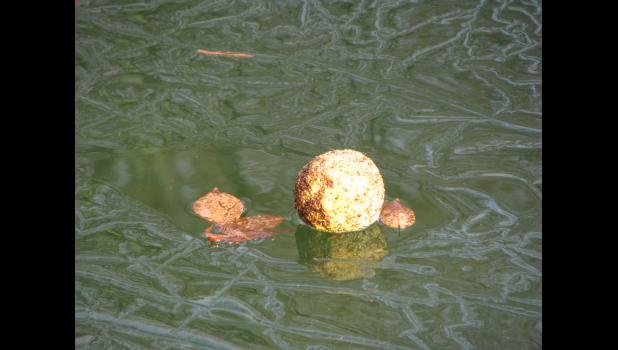Please read this...A hedge apple by any other name...
There it sat. All by itself. In the midst of melting ice on the surface of a frozen pond in Union County. Maybe the pond is the place where all of those big fish are caught. You know. The famed "local farm pond."
I'm not sure why the object on the melting ice caught my attention. Maybe it was the object's bright green color in the midst of an interesting icy pattern.
The object was a lone hedge apple. The hedge apple also is know as an Osage orange. And as a horse apple. And as a monkey brain.
Until last week, quite honestly, I didn't know about horse apple. Or monkey brain. And, quite honestly, until last week, I didn't know much of anything about hedge apples.
I know we see a lot of hedge apples during the fall in Union County. They make wonderful decorations, along with pumpkins and other squashes and gourds.
For some reason, my curiosity was piqued after seeing the hedge apple on the melting ice. Once again, thanks to that wonder of the modern age, AKA the internet, I was able to learn a little bit more about this fruit.
I guess that was probably the first thing I learned. The hedge apple is a fruit. Specifically, it's the fruit of the osage orange tree.
The University of Nebraska Lincoln Extension website suggested that I wasn't the only one who didn't know much about the hedge apple. The website had an article which explained: "Many people have heard that these fruits can be used as an insect repellent, but the truth is that many people don't know much else about this unusual tree and its fruit."
For example, and here comes your word for the week, did you know that the Osange orange is "dioecious, meaning that the male and female flowers are produced on separate trees." And how do you tell a female tree from a male tree? Just pick one up and look at its backside.
In September or October, the female trees produce fruit which is about 3 to 5 inches in diameter that falls to the ground.
The tree is native to "a small area in eastern Texas, southeastern Oklahoma and southwestern Arkansas. This region is the home of the Osage Indians which gives the tree its common name. Settlers found that the Osage orange transplanted easily, tolerated poor soils, extreme heat and strong winds and had no serious insect or disease problems."
The trees were "widely planted in the Midwest as a living fence because, when pruned into a hedge, (they) provided an impenetrable barrier to livestock. The development of barbed wire curtailed its widespread planting, but many Osage orange trees can still be found in fence rows."
The tree's wood is said to be "extremely hard, heavy, durable and shrinks or swells little compared to the wood of other trees. The wood is used for fence posts, treenails, furniture and archery bows. In fact, many archers consider the wood of the Osage orange to be the world's finest wood for bows."
The wood of the Osage orange tree may be good for something, but the fruit, not so much. "The fruit of the Osage orange is a nuisance in the home landscape and has little value," the Extension website shared. A botanist who was quoted on the Missouri Department of Conservation website just flat out stated: "I think it's just hard for people to accept the notion that something so cool and abundant is useless." Kind of like this column...
Some folks, including yours truly, have heard that hedge apples are good for keeping bugs away. Guess not.
I did learn that seeds from the Osage orange apparently have "anti-inflammatory properties," according to an article on NPR's website. With that in mind, it seems that a chemist in Iowa came up with some sort of "pricy cosmetic oil" from the seeds of the Osage orange and developed a product which was given a fancy name: pomifera.
Makeup artists in New York City (of course) liked the otherwise useless pomifera, and were willing to pay 85 bucks for a half ounce of the stuff. Ah, city folks.
Oh, squirrels seem to like the fruit, too. And I'm guessing they're not paying 85 bucks for a half-ounce snack. I wonder if hedge hogs like hedge apples. I wouldn't hedge a bet on that. Sorry.
As always, thank you for reading this. And, yes, this week's column is proof that my brain waves froze in the cold.
***
(For the record: sources for the information in this fascinating article were posted by Dr. Barbara Ogg, an Extension educator at the University of Nebraska Lincoln, the Missouri Department of Conservation and National Public Radio.)

